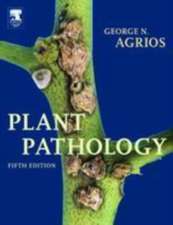Fungicide Resistance in Plant Pathogens: Principles and a Guide to Practical Management
Editat de Hideo Ishii, Derek William Hollomonen Limba Engleză Hardback – 14 sep 2015
Well referenced throughout, the book offers a comprehensive account of resistance, which will be useful as a source of material for lecturers and for both industrial and academic scientists involved in fungicide resistance research. It is also a valuable sourcebook for students.
| Toate formatele și edițiile | Preț | Express |
|---|---|---|
| Paperback (1) | 825.68 lei 38-44 zile | |
| Springer – 23 oct 2016 | 825.68 lei 38-44 zile | |
| Hardback (1) | 1404.15 lei 3-5 săpt. | |
| Springer – 14 sep 2015 | 1404.15 lei 3-5 săpt. |
Preț: 1404.15 lei
Preț vechi: 1712.38 lei
-18% Nou
Puncte Express: 2106
Preț estimativ în valută:
268.69€ • 281.24$ • 223.63£
268.69€ • 281.24$ • 223.63£
Carte disponibilă
Livrare economică 10-24 martie
Preluare comenzi: 021 569.72.76
Specificații
ISBN-13: 9784431556411
ISBN-10: 4431556419
Pagini: 480
Ilustrații: IX, 490 p. 88 illus., 49 illus. in color.
Dimensiuni: 155 x 235 x 31 mm
Greutate: 1.11 kg
Ediția:1st ed. 2015
Editura: Springer
Colecția Springer
Locul publicării:Tokyo, Japan
ISBN-10: 4431556419
Pagini: 480
Ilustrații: IX, 490 p. 88 illus., 49 illus. in color.
Dimensiuni: 155 x 235 x 31 mm
Greutate: 1.11 kg
Ediția:1st ed. 2015
Editura: Springer
Colecția Springer
Locul publicării:Tokyo, Japan
Public țintă
ResearchCuprins
PART I DEVELOPMENT OF FUNGICIDE RESISTANCE.- 1 Fungicide Resistance: 40 Years on and Still a Major Problem.- 2 Genetics of Fungicide Resistance.- 3 Stability of Resistance.- 4 Modelling Analysis of Resistance Management: The Use of Mathematical Models to Guide Fungicide Resistance Management Decisions.- 5 Modelling Analysis of Resistance Management: Evidence Based Resistance Management.- 6 Fitness Cost of Resistance: Impact on Management.- PART II MECHANISMS OF RESISTANCE.- 7 Anti-Tubulin Agents.- 8 Respiration Inhibitors: Complex II.- 9 Respiration Inhibitors: Complex III.- 10 Oomycete Fungicides: Phenylamides, Quinone outside Inhibitors and Carboxylic Acid Amides.- 11 Melanin Biosynthesis Inhibitors.- 12 Histidine Kinase Inhibitors.- 13 Sterol Biosynthesis Inhibitors: C-14 Demethylation (DMIs).- 14 Sterol biosynthesis inhibitors: C-4 demethylation.- 15 Multidrug Efflux Transporters.- PART III MONITORING RESISTANCE.- 16 Monitoring Resistance in Obligate Pathogens by Bioassays Relating to Field Use: Grapevine Powdery and Downy Mildews.- 17 Monitoring Resistance by Bioassay: Relating Results to Field Use Using Culturing Methods.- 18 Monitoring Resistance Using Molecular Methods.- PART IV RESISTANCE MANAGEMENT IN MAJOR CROPS.- 19 Wheat Pathogens in China.- 20 Origin of Fungicide Resistant Barley Powdery Mildew in West Australia: Lessons to be learned.- 21 Rice pathogens in Japan.- 22 Potato Pathogens in Northern and Western Europe.- 23 Sugar Beet Diseases: Cercospora Leaf Spot.- 24 Oilseed Rape Pathogens in France.- 25 Cucurbit Powdery Mildew in the USA.- 26 Grapevine Gray Mold in France.- 27 Fungicide Resistance in Venturia Inaequalis, the Causal Agent of Apple Scab, in the United States.- 28 Resistance in Postharvest Pathogens of Citrus in the United States.- 29 Banana Diseases.
Textul de pe ultima copertă
This volume offers a comprehensive coverage of the general principles and recent advances in fungicide resistance. It describes the development, mechanisms, monitoring and management of resistance, and covers the most important group of fungicides that have caused resistance on various crops. An historical review of fungicide resistance over the past 40 years sets the scene for up-to-date basic information on mode of action, as well as the genetics, mechanisms, and evolution of resistance. Monitoring for resistance, including the latest developments in molecular diagnostics, moves readers into the practical aspects of resistance management, which is dealt with through a series of case studies outlining fungicide-use strategies on several key crops. The chapters reflect the experience of authors internationally recognised for their significant contributions to fungicide resistance research. The majority of crop diseases are caused by fungal pathogens, and disease control relies heavily on chemically synthesized fungicides. However, modern fungicides often encounter the problem of resistance development in target pathogens. Thus pathogen resistance to fungicides is an important factor that causes loss of yield and quality of crops. It often threatens biosecurity through the decrease of fungicide efficacy in the fields. To manage fungicide resistance successfully will require the promotion of integrated disease management, involving not just chemical fungicides, but also hostplant resistance, agronomic factors, and reliable biological control agents where these are available.
Well referenced throughout, the book offers a comprehensive account of resistance, which will be useful as a source of material for lecturers and for both industrial and academic scientists involved in fungicide resistance research. It is also a valuable sourcebook for students.
Well referenced throughout, the book offers a comprehensive account of resistance, which will be useful as a source of material for lecturers and for both industrial and academic scientists involved in fungicide resistance research. It is also a valuable sourcebook for students.
Caracteristici
Combines the basic science that underpins the successful management of resistance, with practical examples of disease control strategies used on many crops Presents resistance management in major crops worldwide, including countries and regions in North and South America, Europe, and Asia Helps the reader to keep abreast of current information on fungicide resistance Comprises chapters that are well organized and easy to understand Includes supplementary material: sn.pub/extras







